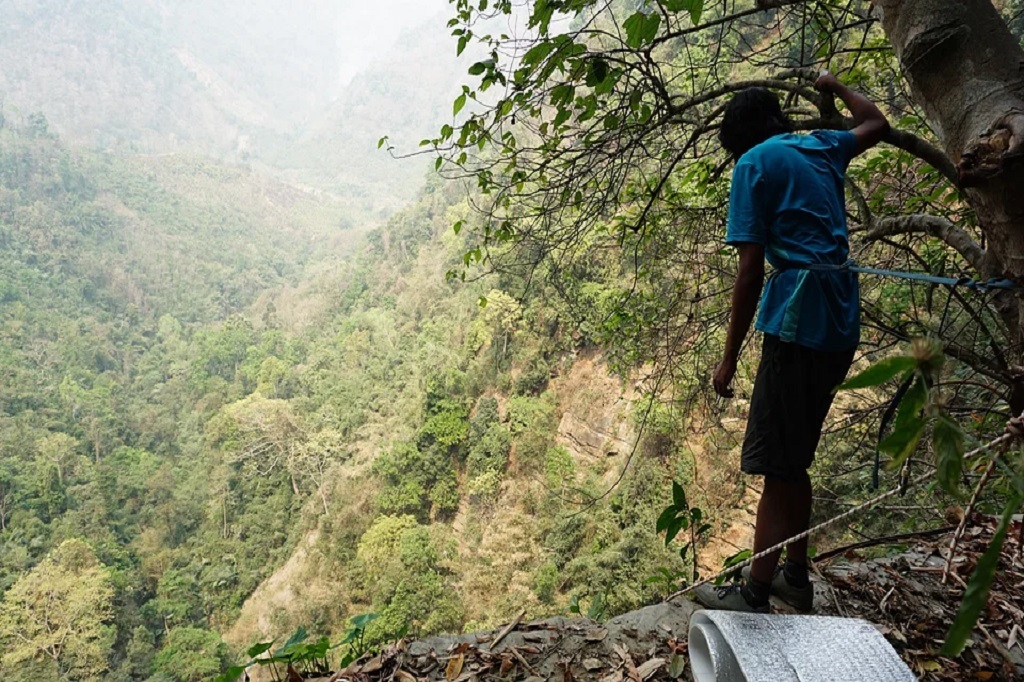At the very edge of the ditch, the legs stopped automatically

I came to Bandarban to collect information about a waterfall in Thanchi on behalf of the research team of Travelers of Bangladesh. This time not only trekking, we will also rappel down from a high waterfall.
I reached Pao-o at around eight o’clock in the evening with the heat on my head along the dusty dirt road. It is a khumipara. At night, I got important information about the waterfall by talking with the village elders in Karbari Dada’s house. There is a small bat cave where the stream falls down. Bats are called Langlok in Marma language, Jhiri and Prapat are also called by the same name.
Our work started from the next morning. To measure the height we have to go to the falls. I went down to Jhiri with all the tools from the neighborhood. Crossing two small streams we descended into the main stream. Big stones have risen due to lack of water. The mountains on both sides are steep. Sunlight does not penetrate here as the entire trail is covered with huge trees. Moving very carefully, we came to the very mouth of the waterfall.
At the very edge of the ditch, the legs stopped automatically. The whole sky came down before me. In the chest then the primal excitement is jumping. I leaned a little to see what was under the shaft. Crossing the bottomless void, the eyes stuck to the various shapes of stone chai. I am literally standing on the edge of the abyss! Thousands of small birds are flying in front of the eyes. It was as if someone had transported me to the kingdom of Pandora, thousands of light years away.
As I contemplate these skies, Intiaz finds a sturdy tree to anchor. For anchors we need at least two strong trees side by side. If two trees are tied with a rope, they will take the shape of the English letter ‘V’. By anchoring in this way, the load will be equally distributed on both trees. No single plant will be overstressed. Even if the climber accidentally free falls, the anchor can easily accommodate the sudden pressure on the rope.
Intiaz and Munim anchored and hung the main rope back and forth, though not side by side. This time we will rappel down from the top of Langlok waterfall one by one.
No one has ever measured the height of this waterfall before. Looking at this gigantic waterfall from below, one can only get an idea of its height. Initially, I guessed with bare eyes, the height would be 300-350 feet. Based on that calculation, we have brought two ropes of 200 feet. There was another 50 feet extra rope. But such a risky adventure cannot be done depending on guesswork.
So to get a basic idea of the height of the falls I dropped a big rock from the top. After 12 seconds the sound of falling was heard. From gravity and fall I guess the height will be around 380 feet. We then measured the height using the brute force method. I tied a weight on a long rope and slowly lowered it down from the top of the cliff. We set a rappel line to the side to make sure the fall line is level and the rope doesn’t get stuck anywhere and the rope reaches right where it touches the water.
Another purpose of rappelling from top to bottom of a cliff is to get a good idea of its size and shape. From here begins the most challenging and risky part of our expedition. From now on every work should be done with a very cool head and focus. There is no room for error here.
Setting the anchor, reading all the gear, we were all in a state of uncertainty until Intiaz started descending first. Everything is fine, there is no mistake anywhere? Such thoughts were running through his mind. Intiaz went ahead to check the rappel line first. Also took harness, helmet, carabiner, descender and a set of zoomers for special needs. The descender, which looked like a Bengali four, slipped out of the shaft by hooking the rope attached to his waist. Then with a long breath he took the first leap and swooped down and disappeared over the edge of the chasm. After a long time I was overcome with joy when I saw an orange figure descend safely. One by one Munim, Aneek, Sandeep, Shamim rappelled down like routine work.
Then it was my turn. I have rappelled so many times in my life, I have rappelled down from high towers with all my trust in the rope, yet when I stood at the edge of the chasm fully prepared, my chest started to thump with excitement. Last-minute apprehension—won’t the rope break? The thought disappeared immediately. As per the rules, I bent my knees and pushed the wall of the waterfall and moved away and at the same time I moved down a little while touching the safety line held in my left hand. Push with both legs again to move the body towards the wall due to the pull of gravity, Once again the rock and drop. The wall ends after 30-40 feet of descent. The waterfall did not descend completely steeply. After going down as steep as 20 feet, the wall has taken a concave shape inwards. The distance from the water line to the wall at the middle point is about 40 feet. I saw nests of Nepalese house martins floating on the wall in mid-sky. It felt like I was floating in the sky for an eternity. At one point, we reached the end of the rope and came down safely. Ended my Langlok Canyoning.




